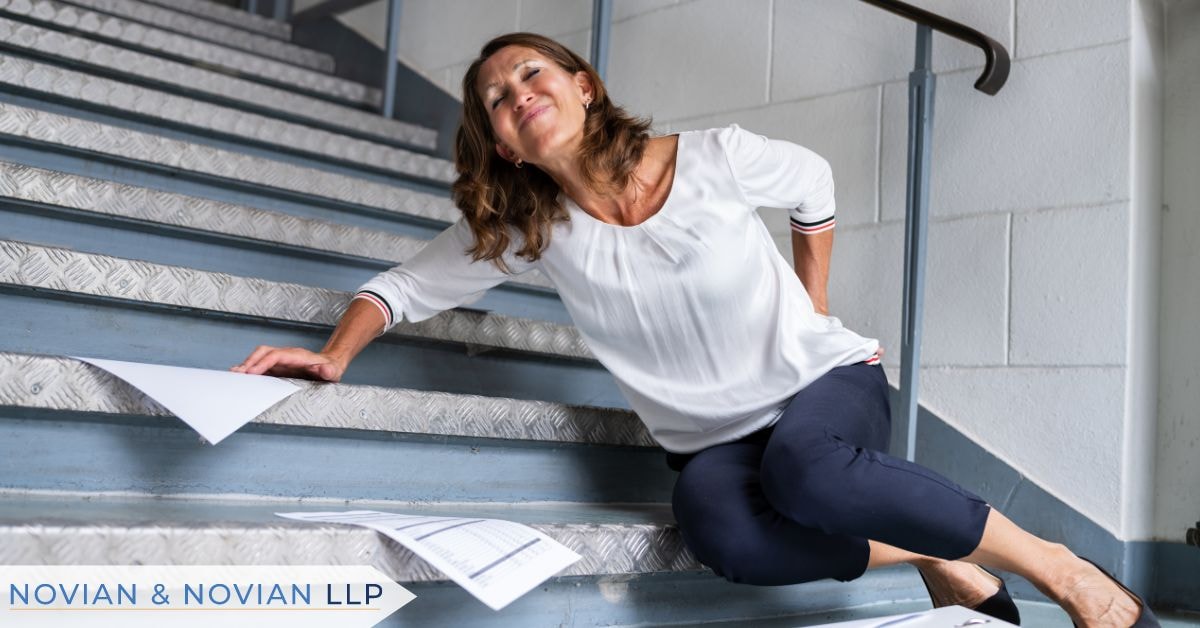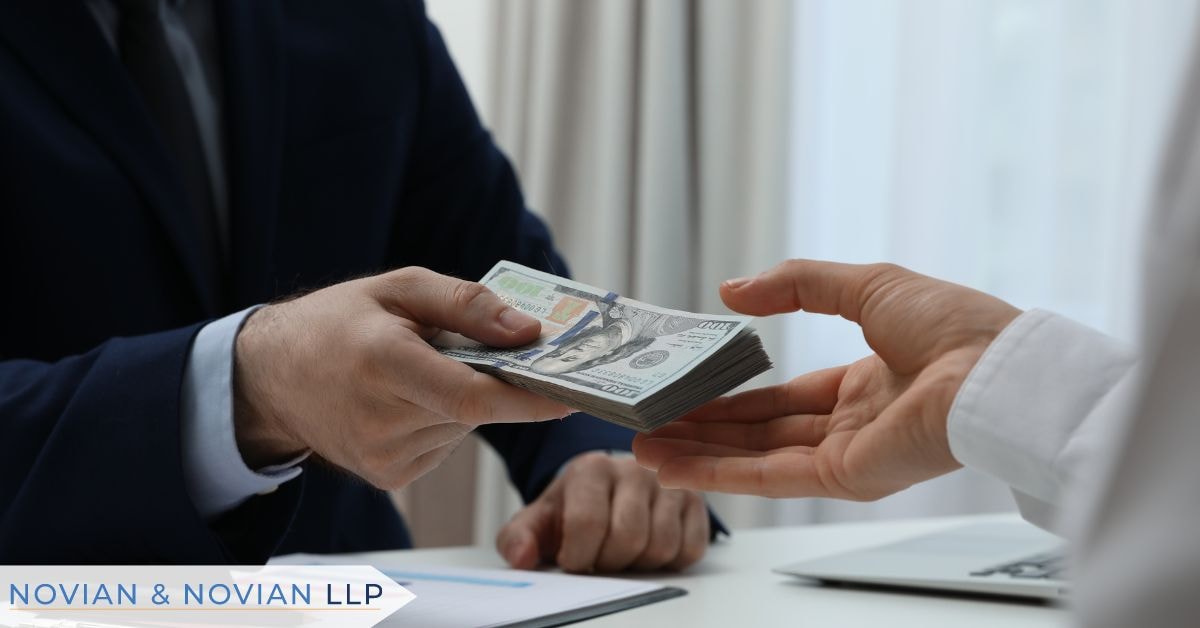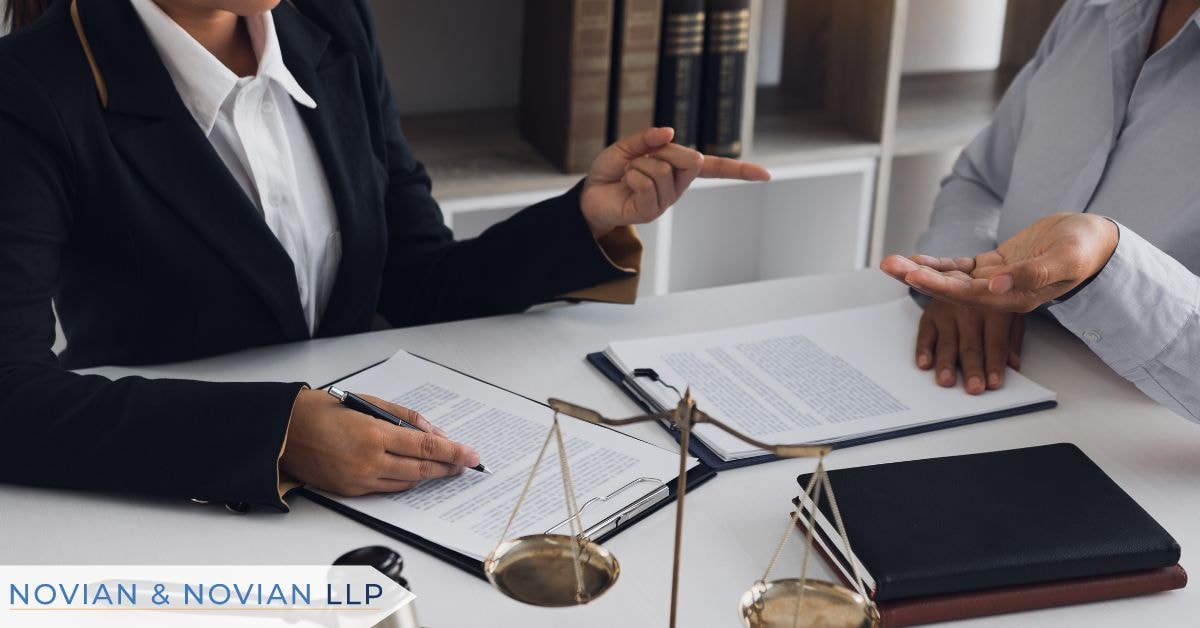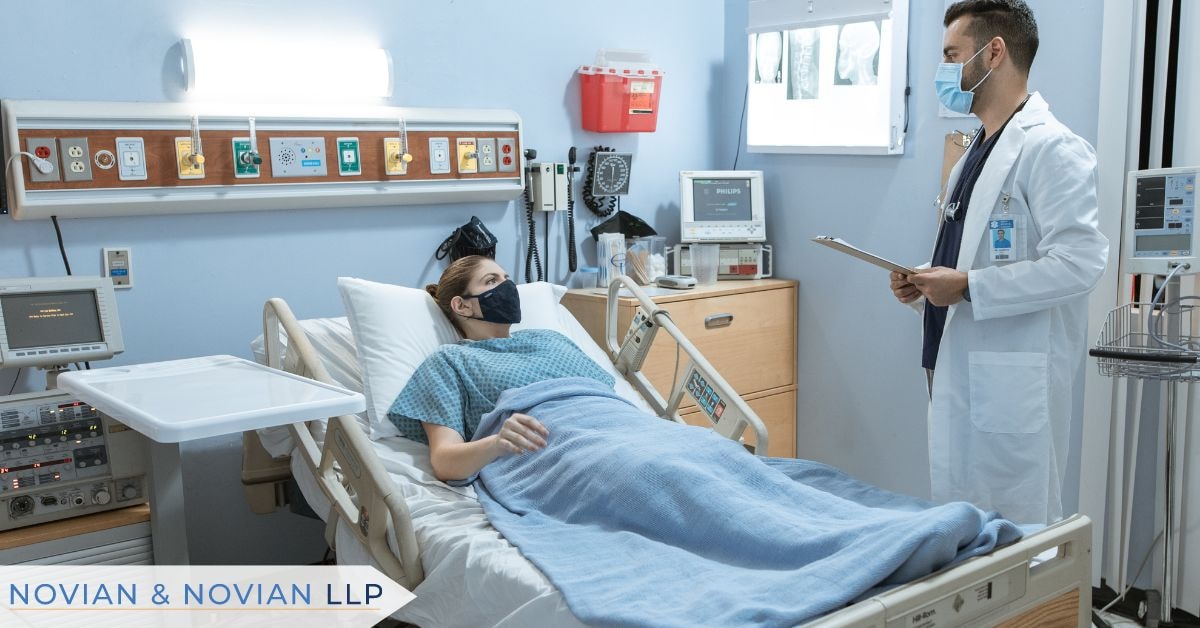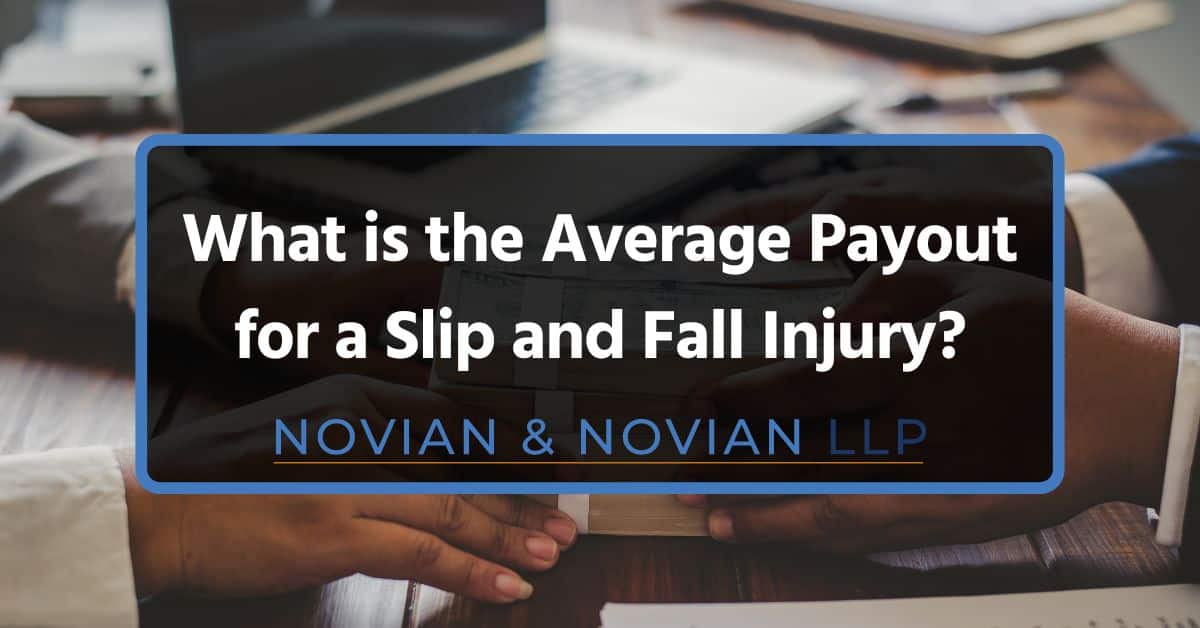
| September 16, 2024 | Catastrophic Injury
Slip-and-fall injuries are often caused by hazards like wet floors, uneven surfaces, or poor lighting, and the consequences can be severe. These accidents can lead to unexpected medical expenses, lost wages, and long-term physical challenges.
The average payout for a slip-and-fall injury can vary widely based on factors such as the severity of the injury, medical costs, and liability. On average, settlements can range from $10,000 to over $50,000, with severe cases potentially exceeding these figures. This compensation helps victims cover medical bills, rehabilitation, lost wages, and sometimes pain and suffering.
If you’ve experienced a slip-and-fall injury in California and are seeking compensation, you should work with experienced attorneys to maximize your claim. At Novian & Novian, we have over 30 years of experience, helping clients get the best interest from their various claims, including catastrophic injury claims. Schedule a free consultation with us now regarding your slip-and-fall injury.
In this blog, we will define a slip-and-fall injury and state the average payout for this sort of accident, highlighting the various factors affecting slip-and-fall case payouts. We will also talk about the steps to take after a slip-and-fall accident.
What Is a Slip-and-Fall Injury?
A slip-and-fall injury occurs when a person slips, trips, or falls on someone else’s property, resulting in an injury. These accidents are common in places like grocery stores, office buildings, and private properties. Property owners are legally obligated to maintain a safe environment, and when they fail to do so, they may be held liable under premises liability laws.
Premises liability laws hold property owners accountable for maintaining safe conditions. If a property owner fails to fix or warn of a dangerous condition, and someone is injured as a result, they may be liable for the victim’s medical bills, lost wages, and other damages. However, these laws also consider the injured party’s role in the accident. Under comparative negligence rules, if the injured party is found partially at fault, their compensation may be reduced proportionally.
Typically, there are two main types of comparative negligence rules. There is the pure comparative negligence and modified comparative negligence. The pure comparative negligence rule allows the plaintiff to recover damages even if they are assigned 99% fault for the accident. However, modified comparative negligence does not allow the plaintiff to recover monetary damages if they are assigned beyond a certain percentage. The percentages differ by state.
You can still recover compensation, even if the accident was partially your fault. Comparative negligence rules allow you to receive compensation, but the settlement amount will be reduced by the percentage of your responsibility. For example, if you are found to be 20% at fault, your compensation will be reduced by 20%.
Slip-and-fall accidents are commonly caused by wet or slippery floors, uneven surfaces, cluttered walkways, and loose carpets or floor mats. Typically, slip-and-fall accidents can lead to various injuries, ranging from minor to severe. A common example is fractures and broken bones that affect wrists, hips, and ankles. They could also lead to head injuries like concussions or traumatic brain injuries (TBI), spinal injuries like slipped discs or spinal cord damage, and soft tissue injuries like sprains, strains, or tears in muscles and ligaments.
What Is the Average Payout for Slip-and-Fall Injury?
The nationwide average payout for slip-and-fall injuries varies based on the severity of the injuries, the medical expenses involved, and the impact on the victim’s life. Slip-and-fall settlements can range from a few thousand dollars for minor injuries to over $50,000 for severe cases.
If it is a minor injury, the average payout would be around $10,000-$20,000. These injuries usually involve short-term recovery with minimal medical intervention, leading to smaller settlements. It could be soft tissue injuries like sprains, minor bruises, and small cuts.
On the other hand, the average payout for moderate injuries like fractures, dislocations, or significant sprains would be around $20,000-$35,000. Moderate injuries often require surgery, rehabilitation, and longer recovery periods, increasing the compensation amount to account for medical bills, lost wages, and pain and suffering.
Moreover, severe injuries may involve long-term or permanent disability. These would result in high medical costs, ongoing care, and a loss of earning capacity. These factors contribute to much larger settlement amounts, bringing the average paying to $35,000-$50,000 or more. Severe injuries could be traumatic brain injuries, spinal cord injuries, or multiple fractures.
Factors Affecting Slip-and-Fall Case Payouts
Slip-and-fall settlements usually vary depending on several key factors that influence the amount of compensation an injured party may receive. Some of these factors are:
Severity of Injury
The severity of the injury plays a role in determining the slip-and-fall settlement amount. The more severe the injury, the higher the compensation will likely be. Serious injuries such as traumatic brain injuries, broken bones, and long-term physical pain usually result in higher settlements, as they require extensive medical care and rehabilitation.
Medical Expenses
Medical bills are another major factor affecting slip-and-fall case payouts, as costs may include hospital bills, surgeries, rehabilitation, medications, and ongoing treatment. The greater the medical expenses, the higher the potential compensation to cover these costs.
You must ensure that all medical records are well-documented. This will increase the chance of recovering significant compensation for the injuries sustained.
Lost Wages and Earning Capacity
When an injury forces someone to take time off work, their lost wages must be calculated into the settlement. In the case of severe injuries, the victim’s future earning potential or earning capacity might be reduced, impacting the overall settlement. Therefore, compensation must cover both lost wages and any future earnings the injured party can no longer obtain due to their fall injury.
Pain and Suffering
Pain and suffering, including emotional distress and long-term pain, also factor into the payout. These non-economic damages are harder to calculate but are just as important as medical bills and lost wages. A strong case presented by an experienced personal injury attorney can help ensure fair compensation for the physical pain and psychological impact of the accident.
Liability and Negligence
Proving fault and negligence of the property owner can also help in determining the settlement amount. If it is clear that the property owner failed to maintain safe conditions, the payout can be substantial. However, if comparative negligence rules apply, and the injured party is partially at fault, the compensation may be reduced.
Insurance Policy Limits
The insurance company’s policy limits may cap the payout amount. While property owners typically have liability insurance, the final settlement may be limited by the coverage amount of their insurance policy.
If the insurance company offers a low settlement, consulting an experienced personal injury attorney is necessary to ensure you receive a fair settlement.
Steps to Take After a Slip-and-Fall Accident
The first step following a fall accident is to prioritize your safety and seek medical attention. Even if your injuries seem minor at first, it is important to get checked out by a healthcare provider. Keep in mind that your medical records will serve as critical evidence in your slip-and-fall case.
To build a strong slip-and-fall lawsuit, documenting the accident scene and your injuries is important. You need to take photographs of the area where the fall happened, including any hazards that caused the fall incident. It is also important to photograph your injuries as well, such as broken bones or traumatic brain injuries. This documentation can be pivotal in proving premises liability and the property owner’s negligence.
Getting immediate medical care not only ensures your health but also strengthens your fall claim. Your medical bills, doctor’s notes, and other records will be key components in calculating your slip-and-fall settlement. Injuries sustained from a fall, such as physical pain and emotional distress, can take time to manifest, so it is important not to delay medical treatment.
Gathering evidence is another important step. Besides photographs, witness statements should be collected from anyone who saw the fall accident. If the fall happened on commercial property, request an incident report from the business. The more evidence you have, the better your chances of proving fault in a premises liability claim.
Keep in mind that navigating a slip-and-fall claim can be complex. Therefore, working with an experienced personal injury attorney on your side can significantly improve your outcome. An experienced attorney will guide you through the legal process, help gather the necessary evidence, and negotiate with the insurance company for a fair settlement.
If you’re unsure of the steps to take, contact Novian & Novian for a free consultation. We specialize in personal injury cases, ensuring injury victims recover the compensation they deserve.
Once you’ve documented your injuries, received medical care, and consulted with an attorney, it is time to file a claim. A slip-and-fall attorney will help you determine the average payout for slip-and-fall injury cases similar to yours and work to ensure your fall case settlement reflects the full extent of your losses, including lost wages, medical expenses, and non-economic damages like pain and suffering.
The Role of a Personal Injury Lawyer
In personal injury cases, having a personal injury lawyer on your side can significantly impact your potential payout. A knowledgeable personal injury attorney can maximize your payout by thoroughly investigating your case, gathering evidence, and negotiating with the insurance company. They understand how to build a strong case and ensure you receive compensation that reflects the true value of your injuries sustained.
Lawyers also help in cases where liability is disputed. Proving negligence or fault in slip-and-fall settlements or other personal injury claims requires legal expertise. Without the proper guidance, you may settle for far less than what your case is worth. Thus, a lawyer prevents property owners or insurance adjusters from taking advantage of you by offering a low settlement.
When you work with an experienced personal injury attorney, they will handle the legal aspects of your case, allowing you to focus on recovery. Your lawyer may also prepare your case for trial if a fair settlement cannot be reached during negotiations. Having an attorney who is prepared to go to court can motivate insurance companies to offer higher payouts.
Without an attorney, you risk accepting a fall case settlement or slip-and-fall lawsuit payout that does not fully compensate for your injuries and financial losses. Insurance companies often aim to settle quickly and for as little as possible, especially if the injured party is not represented by legal counsel. You may also miss out on compensation for emotional distress and long-term physical pain.
Additionally, the legal process can be overwhelming. Mistakes in filing claims, gathering evidence, or proving liability can result in reduced compensation or even a denied claim. Hiring an attorney ensures your case is handled professionally, protecting your rights and increasing your chances of receiving fair compensation.
How to Maximize Your Slip-and-Fall Settlement?
After a slip-and-fall accident, you must seek medical attention right away. Not only will this ensure that your injuries are properly treated, but it also creates a medical record of your injuries sustained. It is also important to follow through with your doctor’s treatment plan, as this demonstrates that your medical bills and treatments are valid and necessary, as insurance companies will look at your commitment to treatment when evaluating your slip-and-fall claim.
Furthermore, you must keep detailed records of all medical expenses, including hospital bills, medications, and rehabilitation costs. Additionally, document the fall by taking photos of the scene, obtaining witness statements, and filing an incident report with the property owner. Collecting this evidence strengthens your case by demonstrating the extent of your fall injuries and the property owner’s negligence.
Moreover, you have to demonstrate liability clearly by establishing the property owner’s liability. This involves proving that they were negligent in maintaining a safe environment and that this negligence led to your slip-and-fall injury. Typically, premises liability laws require property owners to maintain reasonably safe conditions, and demonstrating their failure to do so is key to increasing your fall case settlement.
After filing your slip-and-fall lawsuit, the insurance company may offer a quick settlement. While this might be tempting, it’s often a lowball offer meant to close the case quickly and save the insurer money. Therefore, you must avoid quick settlement offers and not settle too early. Instead, take time to assess the full extent of your injuries, lost wages, and future medical needs before agreeing to any payout.
When negotiating your slip-and-fall settlement, include compensation for future damages, such as ongoing medical expenses, future lost wages, and potential emotional distress. Many injury victims require long-term care or rehabilitation, and a fall settlement should reflect the full scope of damages. Additionally, working with an attorney would greatly help you with these negotiations.
Importantly, do not admit fault after a slip-and-fall after a slip-and-fall accident. It is one of the most common mistakes that people make, and you shouldn’t, as even an innocent comment like “I wasn’t paying attention” can be used against you in a personal injury lawsuit. Rather, stick to the facts and avoid making any statements that could weaken your case.
How Long Does it Take to Settle a Slip-and-fall Claim?
The time it takes to settle a slip-and-fall claim can vary greatly depending on several factors. Generally, it can take anywhere from a few months to several years to reach a settlement. The duration depends on factors such as the severity of injuries, establishing liability, negotiations with insurance companies, medical recovery, and litigation process.
If your injuries are minor and straightforward, a slip-and-fall settlement may be reached within a few months. However, severe injuries involving extensive treatment or long-term care can prolong the process as both parties work to assess the full extent of medical expenses, lost wages, and future damages.
Need an Experienced Personal Injury Attorney?
When it comes to slip-and-fall injuries, several factors can influence your average payout, including the severity of your injuries, medical expenses, lost wages, pain and suffering, and the level of negligence involved. A fair settlement depends on a strong case backed by clear evidence and expert legal representation.
Typically, the average payout for a slip-and-fall injury is between $10,000-$50,000. To ensure you receive the compensation you deserve, you should seek the guidance of an experienced personal injury attorney. They can evaluate the specifics of your case, navigate insurance company negotiations, and maximize your slip-and-fall settlement.
Looking for a personal injury attorney in Los Angeles? Contact Novian & Novian today for a free consultation to discuss your case. We are here for you!
Contact Us
Have questions about this post? Novian & Novian is a full service law firm in Los Angeles with clients that span the country. Contact us today for a free consultation.
Contact Us
Have questions about this post? Novian & Novian is a full service law firm in Los Angeles with clients that span the country. Contact us today for a free consultation.
